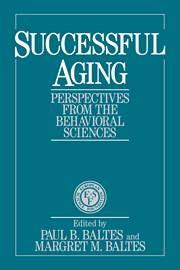Book contents
- Frontmatter
- Contents
- List of contributors
- Foreword
- Preface
- 1 Psychological perspectives on successful aging: The model of selective optimization with compensation
- 2 Medical perspectives upon successful aging
- 3 Successful aging in a post-retired society
- 4 The optimization of cognitive functioning in old age: Predictions based on cohort-sequential and longitudinal data
- 5 The optimization of episodic remembering in old age
- 6 Peak performance and age: An examination of peak performance in sports
- 7 Personal control over development and quality of life perspectives in adulthood
- 8 Successful mastery of bereavement and widowhood: A life-course perspective
- 9 The Bonn Longitudinal Study of Aging: Coping, life adjustment, and life satisfaction
- 10 Risk and protective factors in the transition to young adulthood
- 11 Avoiding negative life outcomes: Evidence from a forty-five year study
- 12 Developmental behavioral genetics and successful aging
- Name index
- Subject index
11 - Avoiding negative life outcomes: Evidence from a forty-five year study
Published online by Cambridge University Press: 22 March 2010
- Frontmatter
- Contents
- List of contributors
- Foreword
- Preface
- 1 Psychological perspectives on successful aging: The model of selective optimization with compensation
- 2 Medical perspectives upon successful aging
- 3 Successful aging in a post-retired society
- 4 The optimization of cognitive functioning in old age: Predictions based on cohort-sequential and longitudinal data
- 5 The optimization of episodic remembering in old age
- 6 Peak performance and age: An examination of peak performance in sports
- 7 Personal control over development and quality of life perspectives in adulthood
- 8 Successful mastery of bereavement and widowhood: A life-course perspective
- 9 The Bonn Longitudinal Study of Aging: Coping, life adjustment, and life satisfaction
- 10 Risk and protective factors in the transition to young adulthood
- 11 Avoiding negative life outcomes: Evidence from a forty-five year study
- 12 Developmental behavioral genetics and successful aging
- Name index
- Subject index
Summary
Introduction
As we go through life we see vigorous, happy, generative octogenarians, and we wonder what were the relevant antecedents? A definitive answer is not possible. But if gerontology is to understand successful adaptation to aging as well as it understands unsuccessful aging, the parameters and antecedents of successful aging must be addressed.
To better understand successful aging, the longitudinal study of entire cohorts seems valuable for several reasons. First, aging must always be studied as a process, for aging conveys change; it has a past and a future. Second, longitudinal study is necessary to encompass premature death – a negative outcome to be avoided. Third, longitudinal study is also necessary in order to assess predictive validity, the closest we will ever have to a gold standard with which to assess value-laden judgments like relative success in life. For this reason, the present chapter will discuss a 45-year prospective longitudinal study of socially favored men. It will seek to identify the most promising predictors of successful late–mid-life adaptation among 204 Harvard College sophomores, followed since 1940.
As a means of assessing successful aging, the two outcome measures used in this chapter – physical health and psychosocial adjustment – will be organized around the seven-dimensional model of successful aging suggested by Baltes and Baltes earlier in this volume. With the passage of time, progressively diminished physical reserves are an inevitable part of aging, but the rate at which these diminished reserves occur is variable.
- Type
- Chapter
- Information
- Successful AgingPerspectives from the Behavioral Sciences, pp. 332 - 358Publisher: Cambridge University PressPrint publication year: 1990
- 10
- Cited by



